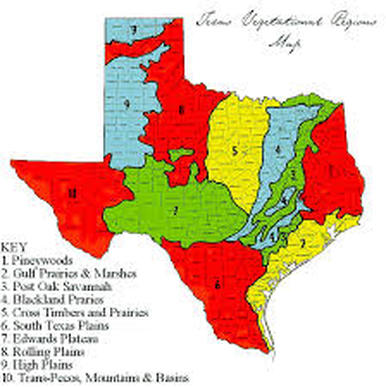Texas Ecoregions
Texas is divided into 10 natural regions or ecoregions.
|
|
An ecoregion of Texas, is an ecosystem within the state. It has plants, animal and climate that are unique to the area. It also has its own climate. For example: The Piney Woods (around Longview) have tall pine trees, while El Paso in the Trans-Pecos region is more desertous and has catcus.
|
Blackland Prairie & Post Oak Savannah
|
|
|
Coastal Sand Plains
|
|
|
Gulf Coast Prairies & Marshes
Edward's Plateau
|
|
|
Gulf Coast Prairies & Marshes
|
|
|
High Plains
|
|
|
Piney Woods
|
|
|
Postoak Savanna
|
|
|
Rolling Plains
South Texas Brush Country
|
|
|
Trans Pecos
|
|
|

